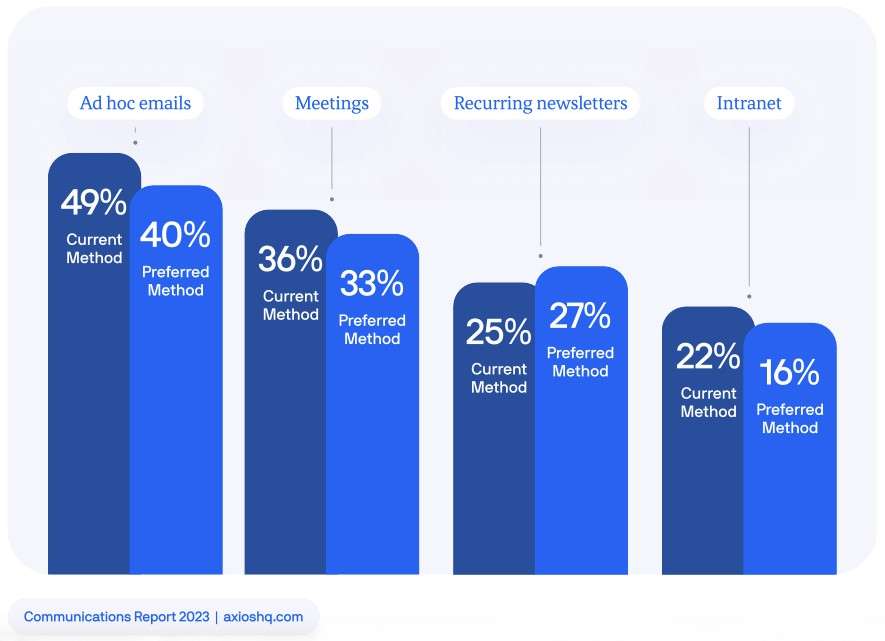The communication channels employees want leaders to use

Ineffective communication is costing U.S. businesses over $15,000 per employee in lost productivity each year, according to IDC and OECD.org data.
- Why it matters: That’s frustrating for everyone. Teams are struggling to find the details they need to do their jobs, and leaders battle breakdowns in alignment, dips in team morale, and slowing progress across the organization because of it.
The key is understanding where employees expect to find critical information and meeting them where they are. To find out how employees best access and digest internal updates, Axios HQ surveyed over 1,500 leaders and employees.
Between the lines: Nearly 70% of what they want lives in their inbox. Across all channels, recurring newsletters are the only one employees say they wish their leaders used more often.
Improve the communication gap
Every leader can benefit from pausing, listening to their audience, and acting on what they need. By doing so, they can close the gap between the updates employees want to receive and the ones leaders are actually sending.
To close that gap, try:
- Checking data to see what’s resonating with your staff or stakeholders.
- Offering more relevant details with clearer formatting to make vital details stand out.
- Running routine surveys to see how your stakeholders prefer to get updates.
Take what you learn, and refresh what details you’re sharing with employees and stakeholders, along with which channels you use to deliver them. It will go a long way toward improving your communication strategy and keeping everyone in your organization aligned and engaged.
Give each channel an identity
Not every message is a fit for every channel. Rather, a full communications strategy needs to be intentional about where employees will be when critical — or casual — updates need to get across. Know where your readers are. Understand what they expect to find in each space. And stick to it.
We’ve spoken to hundreds of leaders, and many leverage their internal channels in a clearly defined, distinct way:
-
“In the moment” messages: These DMs — like the ones you send on Slack or Teams — are fast-moving updates with a short shelf life. Think of things you’d say in the hallway that need to be addressed ASAP, like quick questions or clarifications that keep projects moving forward. Remember that these messages also get buried quickly, and busy employees or folks on vacation may never see them.
-
Ad hoc emails. These are most often one-to-one or small group updates, rather than one-to-many communications. Use these sparingly to synthesize progress, monitor and report issues, and relay opportunities so stakeholders or collaborators stay informed. They’re a good way to share information that you can’t risk letting get missed in a messenger, once folks read it, it can be tough to keep track of or resurface it later.
-
Formal meetings. Whether done in-person or over Zoom, live chats are a powerful space for clarity, creativity, and collaboration. Set an agenda and goals. Make space for folks to ask and answer questions. Offer a pre-read to prepare so you can use the time to its fullest. Whether it’s an all-hands or a team meeting, make the most of everyone’s time.
-
Newsletters. More focused, detailed, and essential than ad hoc emails, company and team newsletters provide an extra layer of trust and consistency. They’re sent on a more reliable and time cadence and contain essential information, divided into focused, digestible areas. This makes them an easy way to continually keep employees updated on the topics they want — and need — to hear about most.
-
Knowledge hubs. Places like your intranet, long-standing systems that document how teams work and what processes are, can be great sources of historical context and insight — if you know where to look. Updates here should have a long shelf life, be relevant to a wide variety of readers. The tough part is helping readers navigate it. The more your organization grows, the deeper readers have to dig to find what they need.
The bottom line: Remember that 40% of employees want more thoughtful and relevant details from the internal communications their leaders share. Set a high bar for what they need, communicate it clearly and directly, meet readers on the channels where they naturally are, and help everyone get smarter, faster.
Go deeper: Understand your employees communication styles to share better, more impactful updates


















.png)


















